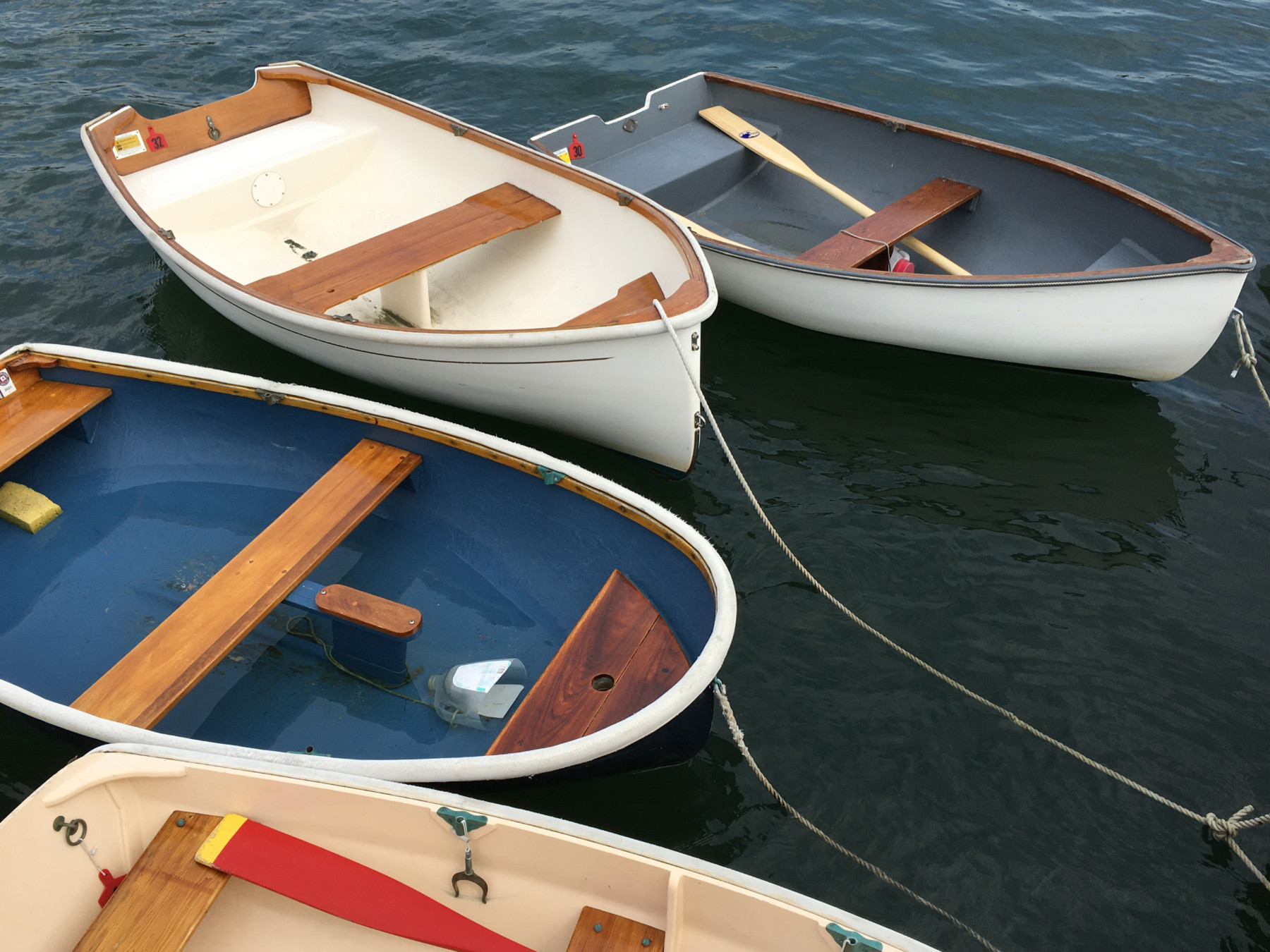Christmas Cove and The Little Skiffs

Christmas Cove
The small roads down the long peninsula eventually became one lane, all the way to a dead end that said: No Turn Around. I made a ten point turn on top of a blind hill, which brought me back to the Lofoten Islands of Norway and that little Peugeot. I always tried to park facing forward because I couldn’t see out the back window. All those steep climbs, blind hills and one lane roads on the edge of a cliff. At least here, I was home, and I could see out the back.
Three young people took up half the road. Without shame because I have Maine plates, I leaned out the window and said, “I’m looking for Christmas Cove.” One of the women moved her hand all around and said, “This is Christmas Cove— but if you want a few docks, turn down this road.”
The road was a stone’s throw ending at a very small country club. Three or four cars were parked on the rich green grass, but no one was there. The view was stunning, peppered with white lobster boats and the small village in the distance.
By that time, it was 2:45, and I had just finished recording the South Bristol lobstermen unloading their catch. Got my camp stool and cooler and walked down the docks to eat. The wind whipped the water and rocked the boats with creaks, knocks and groans. Osprey had built two nests on top of two channel markers. Eventually one and then another flew in— standing on the nest and releasing their piercing cries.
I walked along the docks and listened. Water lapped against a handsome stone wall by the dock where I sat. The last dock was okay, but the first had the loudest and deepest sounds though some of the boats were rubber dinghies that gave a plastic squeak. I got my recording equipment and sat where the stone wall met the water.
The Little Skiffs
With a good number of sounds recorded, I spent the remainder of my stay exploring the tiny harbors, boatyards and the walking trails on my list.
At Round Pond, the docks were busy with lobstermen, the outdoor take-out, and people coming in and out. Three ladies from a school of painting set up across the seascape, each with a wooden easel like Winslow Homer’s.
On the furthest dock, I squeezed by a frumpy woman wearing a white floppy hat and sunglasses. She was painting on a tiny canvas. Muddy colors smudged her palette, much like the ones I mixed as a kid.
I walked down the boat ramp, and that’s when I met the little skiffs. Perfectly shaped, they were in constant motion, crowding and jostling. I was so comfortable and so moved by these little boats that I stayed for a very long time. As a result, it was lunchtime; I walked back for my cooler, stepping by Lady #1 and a few admirers.
Then I passed by the more contemporary Young Woman #2, and glanced over at Lady #3. She was the farthest away and wore field clothes like a bird watcher.
The autumn light kept changing. Suddenly, the sun went in; the sky went dark, and the wind picked up. I went to get my pullover. Then, the sun broke through and the light streamed golden, like when you look for a rainbow.
I watched bald eagles fly by, unnoticed. A few ospreys held fish in their talons like prop planes towing a banner. Laughing gulls, heard more than seen, were the farthest away.
I watched a slow-going elderly lady, dressed from head to toe in pink, make her way down the next dock. Eventually a few others— a son, daughter-in-law and grandkids perhaps, followed. Then, a huge lobster boat pulled up and off they went.
Occasionally someone came down the ramp to look out at my dock. Sometimes people rowed in, or a small family headed out. The exchanges were brief and friendly, except for the young woman who came in with her dog.
Then a man with a camera came down, and I was finally able to express the beauty of the little skiffs. “Yes,” he said, “they are wonderful.” He took many photos and asked if I was from the school of painting.
Later a woman, not as professional as the man, came down with her camera. She looked out onto the water and missed the little boats completely. After some time, I said, “Aren’t they sweet?” “Yes,” she said, “they’re adorable.”
Then a man came in from the water right in front of me. He was rowing boat #31 and needed to tie up between the two skiffs. I reached out and moved a couple boats to help.
The unfriendly young woman was now halfway down the ramp behind me. She knew the man and told him to hurry up.
When he finally stepped onto the dock, I asked whether he could take out any skiff he wanted. “No,” he said, “each person is assigned a boat.” I’m not sure which of the four I would want. Each has its own sweetness, like the dark blue interior of one or the handsome wooden seats of the others. And who could resist the red paddle with the yellow tip?
When it came time to leave, because like Frost, I had many places to go— I tugged each boat goodbye and gave a little salute. By this time, Lady #1 had taken off her hat, and the woman with the camera was now seated down by the boat ramp starting her own little painting. And when I finally reached the parking lot, I noticed that the Pink Lady, too, was heading home.